Don't wanna be here? Send us removal request.
Text

I was at the Anglican tin church in Lara, in County Monaghan. It was featured on RTÉ nationwide.
As Gaedhilg (1600–1945):
‘Cad é seo?’
‘Is é seo an domhnach stáin suimhte i Láithreach i gConntae Mhuineacháin. An tSéipéal Naomh Peadar is ainm do’n eaglais seo.’
As Gaeilge (1945–):
‘Cad é seo?’
‘Is é seo an tséipéal stáin suite i Láithreach i gContae Mhuineacháin. An tSéipéal Naomh Peadar is ainm don eaglais seo.’
In English:
‘What is this?’
‘This is the tin church situated in Lara, in County Monaghan. Saint Patrick’s Church is this church’s name.’
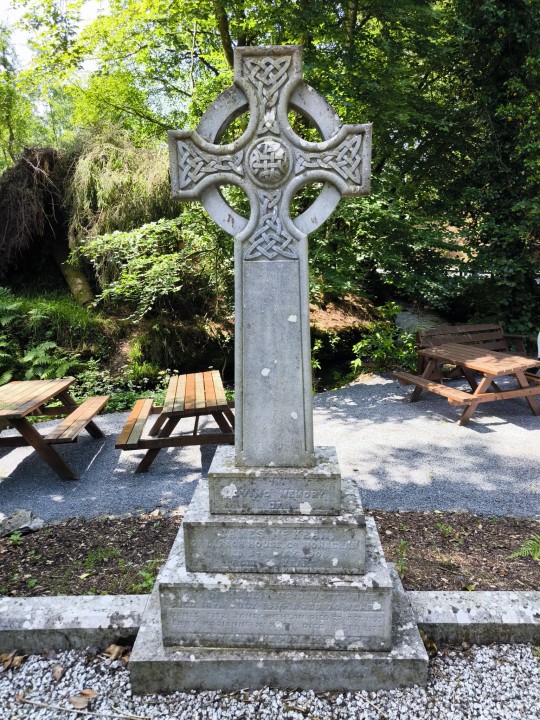
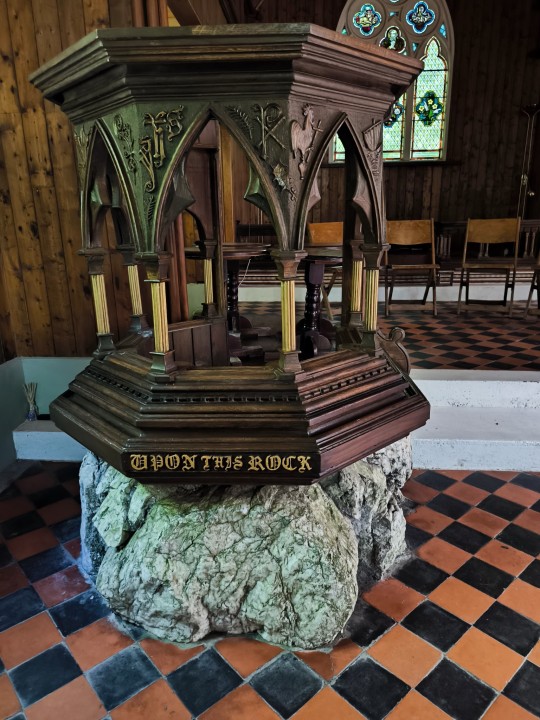


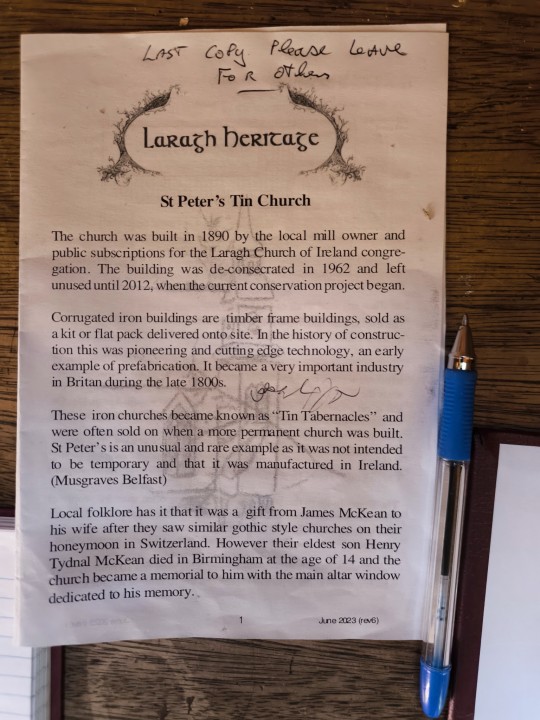


2 notes
·
View notes
Text
A Lovely Irish-Gaelic Phrase Sourced from Dineen:
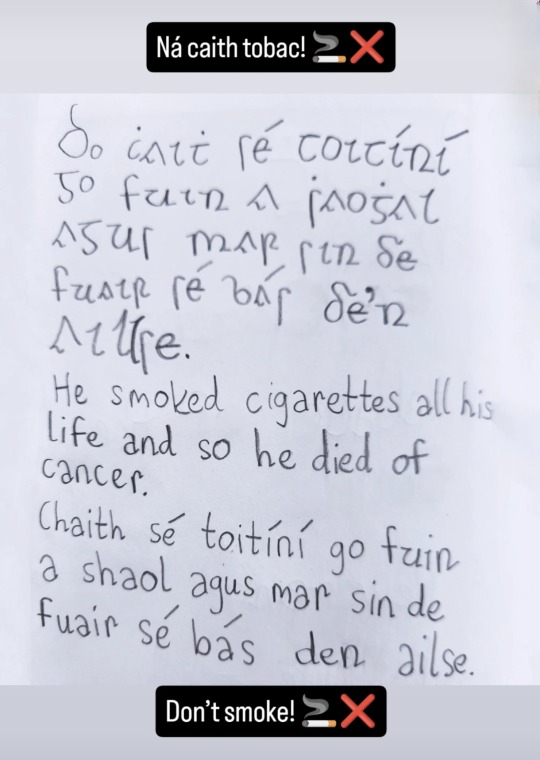
I found the lovely Irish Gaelic phrase: ‘go fuin a shaoghal’, ‘until the end of his life’ in Patrick S. Dineen’s (1860–1934) Irish-English Dictionary 2nd ed. 1927. I then tried to use it in a sentence.
As Gaedhilg (1600–1945):
‘Ná caith tobac!’
As Gaeilge (1945–):
‘Ná caith tobac!’
In Biblical English:
‘Smoke thou not!’
In Modern English:
‘Do not smoke!’
As Gaedhilg: (1600–1945):
‘Do chaith sé toitíní go fuin a shaoghal agus mar sin de fuair sé bás de’n aillse.’
As Gaeilge: (1945–):
‘Chaith sé toitíní go fuin a shaol agus mar sin de fuair sé bás den ailse.’
In English:
‘He smoked all his life, and because of this he died of cancer.’
0 notes
Text
New YouTube video:
https://youtu.be/Ve8C22jYrNk
Jennifer Bird PhD asked, in a thumbnail, the question: How many creation accounts are there in the Bible? I know of three. I discuss all of them in this video, but, in particular, the lesser known 3rd creation account, where the Jewish god slays a sea monster called Rahab, and fashions the created world with its body. I call attention to the Egyptian sky goddess Nut or Nuit who, seems to me to resemble Rahab, in some respects. The scroll in this thumbnail reads, in Hebrew: ‘The Book of Isaiah’ wherefrom I read in this video. I employ the Legacy Standard Bible, in this video, because, as Kipp Davis points out: we really ought to translate the tetragrammaton as ‘Yahweh’ and not as ‘LORD’. The LSB is to be commended for doing this.
____
0 notes
Text
youtube
Video 1: In this YouTube Short, I discuss the Rivulet's frontispiece.

Figure 1: The Rivulet's frontispiece, as recreated by me in Inkscape.
In this video, I discuss a frontispiece from Thomas Toke Lynch’s (1818–1871) The Rivulet (1883) that I recreated by means of pencils, Microsoft Paint 3D and Inkscape. In publishing , a frontispiece is a thematic illustration at the beginning of a book. I hope to bring forth a new edition of this work, eventually.
‘Anchora Speī’
in Latin means:
‘Anchor of Hope’
. This seems to be a theme of this work: i.e. a presentation of songs, or poems of cheer so as to retain hope in a cruel world that provides us with so many temptations to despair.
0 notes
Text
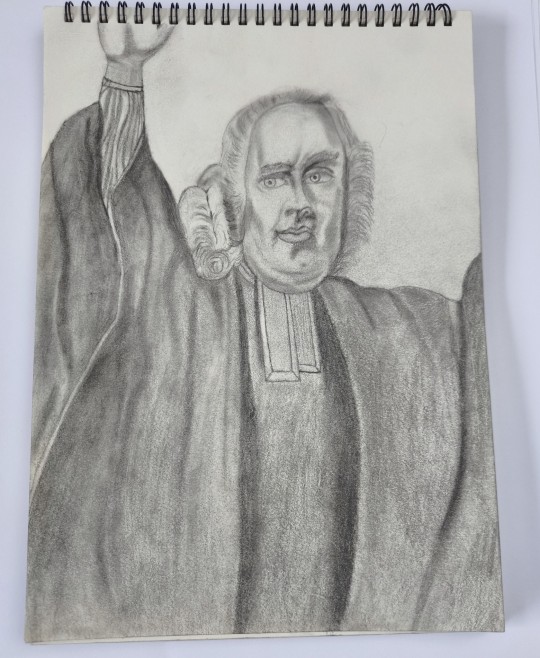
A pencil sketch of George Whitefield (1714–1770) that I am working on. He would raise his hands up and say:
‘Flee from the wrath to come!’
A character! Given his rumoured closeted homosexuality, I tried to capture a bit of a gay twinkle in his eyes.
0 notes
Text
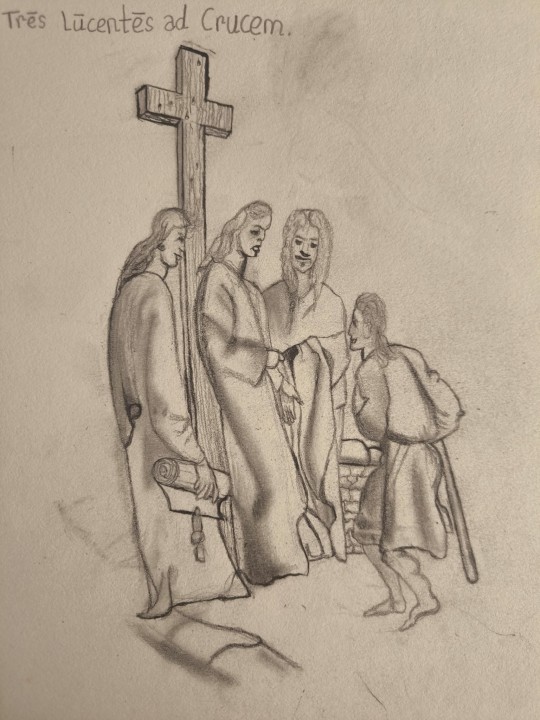
Figure 1: A pencil drawing by me of the Three Shining Ones at the Cross from Pilgrim’s Progress.
The Three Shining Ones at the Cross from Pilgrim’s Progress:
Listening to ‘The Pilgrim’s Progress’ (1678), and books about ‘The Pilgrim’s Progress’ (1678), is how I go to sleep at night. Though I disbelieve in all of Calvinist Christianity’s supernatural claims, nevertheless, I consider ‘The Pilgrim’s Progress’ to be an excellent psychological novel, with much secular import. Derry atheist and socialist, Eamonn McCann commends the anti-capitalist critique of Vanity Fair, in the novel. The magazine, Vanity Fair, is, of course, the magazine that employed the late popularizer of New Atheism, Christopher Hitchens (1949–2011). One of the characters in the Book is of course Atheist, who meets our two Pilgrims as they are traversing the Delectable Mountains, and making their way to Beulah. This part of the allegory denotes middle age, heading into Old Age. Incidentally, Bunyan was 50, when Pilgrim’s Progress was published. I like to see this incident as Bunyan grappling with his own temptations to atheism—which he admits to having in his Memoirs ‘Grace Abounding’ (1666). In my estimation, the writings of Bunyan are a lot more subversive than what they are usually presented as.
If a disbeliever in the supernatural claims of Christianity, then simply imagine the Pilgrims dissolving in the River of Death, and the novel still kinda works.
John Bunyan (1628–1688) is an unlikely atheist hero... however, he has always had atheist admirers. McCann is a contemporary atheist admirer of Bunyan’s. I would love to go and see the John Bunyan museum in Bedford, England, some day. I have family in Bedford.
#christianity #bunyan #drawing #calvinism #reformed #latin #classics #books @eamonnmccann
As I see it, one of the books which Pilgrim’s Progress influenced was ‘Alice’s Adventures Underground’ (1865). Alice says that she only likes books with pictures in them. Pilgrim’s Progress has almost always been published with rich illustrations.
‘Trēs Lūcentēs ad Crucem’ is Latin for: ‘The Three Shining Ones at the Cross’.
#latin#translation#education#language#linguistics#christianity#atheism#theism#drawing#art#books#classics
1 note
·
View note
Text
youtube
Video 1: A short that I made on my YT create app on my android phone.

Figure 1: A rather large house spider that I observed yesterday, and that I took a photo of with my Xiaomi 13T Pro which has a Leica camera built into it.
I saw this big house spider on my wall, and so I took a photo of it, and turned it into a YouTube Short on my YT Create android app.
Transcript:

As Gaeilge (1945–):
Cad é seo ar an mballa? Is é seo damhán alla ar an mballa.
In English:
What is this on the wall? This is a spider on the wall.
0 notes
Text
youtube
Video 1: In this video, I discuss Bertrand Russell’s ideas on what an Irishman’s definition of a net might be, in Irish Gaelic.

Figure 2: Cover art for the Librivox edition of ‘The ABC of Atoms’.
Transcript:
CIARAN AODH MAC ARDGHAIL:
“ Last night, I was reading The ABC of Atoms (1923) by Bertrand Russell (1872–1970). At first, atoms can really only be described by way of analogy, and the analogy that Russell punts for in the book’s introduction is that of a net.

Figure 3: A pencil drawing of a net that I, effected with pencils. I also drew a butterfly. ‘rēte’ is the Latin word for ‘net’. The nedical term: ‘retina’ is related. The ‘rētīna’ — Latin for: ‘net-like stuff’ — is: ‘a region of the eye featuring light-sensitive cells and fed by a net-like mesh of blood vessels’. “ A net, like an atom, is a physical object comprising mostly empty space. Russell then introduces us to an Irishman’s definition of: ‘a net’, which, according to Russell, is: ‘a number of holes tied together with pieces of string.’ Although I, as an Irishman, have never heard this definition of ‘a net’ — and I suspect that few of my Irish compatriots have heard this definition, either — nevertheless, I thought that this might be a swell thing to translate into Irish Gaelic. “

“
Bertrand Russell (1872–1970)
The ABC of Atoms (1923)
“
As Gaeilge: (1945–):
‘Is é sainmhíniú Éireannaigh an fhocail “líontán” ná “uimhir poll ceangailte le chéile le píosa téada.”’
Bertrand Russell (1872–1970)
The ABC of Atoms (1923)
In English:
‘An Irishman’s definition of “a net” is “a number of holes tied together with a piece of string.”’
Bertrand Russell (1872–1970) The ABC of Atoms (1923)
My kofi account:
0 notes
Text
The Rivulet: Hymns for Heart and Voice:
The Rivulet caused a Theological controversy between suspected Modernists, such Thomas Toke Lynch (1818–1871), and Anti-modernists such as Charles Haddon Spurgeon (1834–1892). The Rivulet Controversy has an entire chapter dedicated to it in Spurgeon’s Autobiography, and Ian Murray mentions the Rivulet Controversy of 1855 in his book The Forgotten Spurgeon (1966–2012). Given that I find the History of Calvinism fascinating, I thought that I would record this book as an audiobook so as to give more context to a Theological controversy that embroiled a young Charles Haddon Spurgeon. The below linked video comprises part one of this controversial hymnal.
youtube
Link to Transcript as Word Document:
https://1drv.ms/w/s!Aon4q4RsUuHYhvYIitWI70pf7Te78g?e=jy68II
____
0 notes
Text
‘An Páipéar’: A New Irish-Language Weekly Newspaper:
I have begun to read ‘An Páipéar’—Irish Gaelic for ‘The Paper’—in an effort to improve my reading comprehension as regards the Irish language.
I have an interest in Historical Linguistics—the study of how the grammar of a language evolves through time—which is why I give two versions of the Irish language: the “Classical” Modern Irish, that existed from roughly 1600–1945, as well as today’s Modern Irish as defined by An Caighdeán Oifigiúil (2017). ‘An Caighdeán Oifigiúil’ is Irish Gaelic for: ‘the official standard’. The Irish Government created a proto-version of the Caighdeán in 1945, and has revised the Caighdeán, periodically, since then.
As Gaedhilge (1600–1945):
‘Atáim ag léigheamh ‘An Páipéar’, páipéar nuadhachta seachtmhaineamhail nuadh.’
As Nua-Ghaeilge (1945–):
‘Táim ag léamh ‘An Páipéar’, páipéar nuachta seachtainiúil nua.’
In English:
‘I am reading ‘An Páipéar’, a new weekly newspaper.’
youtube
3 notes
·
View notes
Text
Hi, OP here. There is a difference between transliteration and Phonemic transcription. I explain my idiosyncratic way of transliterating Hebrew in this codepen post. I am following the Classical Biblical pronunciation, which, I think, is still partially used by Modern Yemenite speakers. Yeminite is a dialect, or way of pronouncing, modern Hebrew.

Figure 1: a screenshot of YouTube Thumbnail for a Trailer for the ‘We will dance again’ Documentary.
‘We will dance again.’ in Hebrew:
I learn Hebrew, because it is the language of the Hebrew Old Testament. However, that said, there is a huge overlap, in terms of grammar and vocabulary, as regards Modern Hebrew and Ancient Biblical Hebrew. One thing that fascinates me is Historical Linguistics. Thus, tracing Hebrew as it matures through three stages in the Hebrew Bible, and then as it becomes Talmudic and Medieval Hebrew, and then as it becomes Modern Hebrew in the 1800s, and how that dialect of Hebrew has developed up until today, is something that is extremely interesting to a budding amateur linguist.
That I study Hebrew, in no way signifies that I am a sympathiser of Israel’s.
‘We will dance again.’
in Hebrew would be:
‚אֲנַ֫חְנוּ נִרְק֫וֹד כֵּן שׁוּב.‘
or, transliterated:
‘ʔănác͡hnûw nirəqốwd͡h k͡ħē͡in s͡hûwb͡h.’
‘we will’ is the emphatic future of ‘we shall’. I carried this emphasis over into Hebrew with the adverb: ‘k͡ħē͡in’, which literally means: ‘yes’, and which can be employed as an emphatic, in Hebrew.
However, looking this phrase up online, there appear to be more implicit, or less literal renderings of ‘We will dance again’ employed, and, perhaps, preferred by Modern Hebrew speakers.
In Biblical Hebrew, there isn't really a future tense, and so futurity would have to be indicated in other ways. The adverb, ‘shûwbh’, or, ‘again’, would seem to indicate future action.
What is an imperfective aspect in Biblical Hebrew is a future tense in Modern Hebrew.
Whereas ‘nirəqốwd͡h’, above, represents imperfect aspect in Biblical Hebrew, it represents a future tense in Modern Hebrew.
youtube
6 notes
·
View notes
Text

Figure 1: a screenshot of YouTube Thumbnail for a Trailer for the ‘We will dance again’ Documentary.
‘We will dance again.’ in Hebrew:
I learn Hebrew, because it is the language of the Hebrew Old Testament. However, that said, there is a huge overlap, in terms of grammar and vocabulary, as regards Modern Hebrew and Ancient Biblical Hebrew. One thing that fascinates me is Historical Linguistics. Thus, tracing Hebrew as it matures through three stages in the Hebrew Bible, and then as it becomes Talmudic and Medieval Hebrew, and then as it becomes Modern Hebrew in the 1800s, and how that dialect of Hebrew has developed up until today, is something that is extremely interesting to a budding amateur linguist.
That I study Hebrew, in no way signifies that I am a sympathiser of Israel’s.
‘We will dance again.’
in Hebrew would be:
‚אֲנַ֫חְנוּ נִרְק֫וֹד כֵּן שׁוּב.‘
or, transliterated:
‘ʔănác͡hnûw nirəqốwd͡h k͡ħē͡in s͡hûwb͡h.’
‘we will’ is the emphatic future of ‘we shall’. I carried this emphasis over into Hebrew with the adverb: ‘k͡ħē͡in’, which literally means: ‘yes’, and which can be employed as an emphatic, in Hebrew.
However, looking this phrase up online, there appear to be more implicit, or less literal renderings of ‘We will dance again’ employed, and, perhaps, preferred by Modern Hebrew speakers.
In Biblical Hebrew, there isn't really a future tense, and so futurity would have to be indicated in other ways. The adverb, ‘shûwbh’, or, ‘again’, would seem to indicate future action.
What is an imperfective aspect in Biblical Hebrew is a future tense in Modern Hebrew.
Whereas ‘nirəqốwd͡h’, above, represents imperfect aspect in Biblical Hebrew, it represents a future tense in Modern Hebrew.
youtube
6 notes
·
View notes
Text
The Stony Grey Soil of Monaghan:
as Gaedhilge*:
‘cré clochach liath Mhuineacháin’
nó:
‘ithir clochach liath Mhuineacháin’
Pádraig Caomhánach (1904–1967)
In English:
‘the stony grey soil of Monaghan’
Patrick Kavanagh (1904–1967)
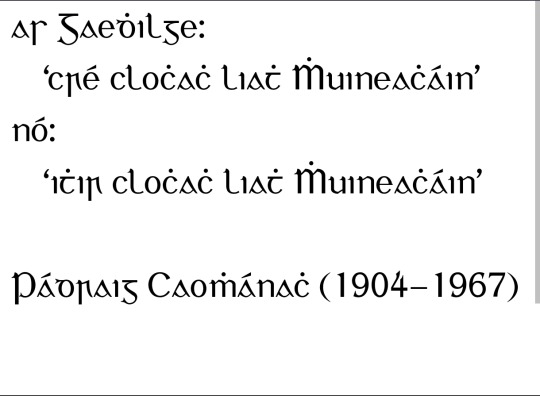
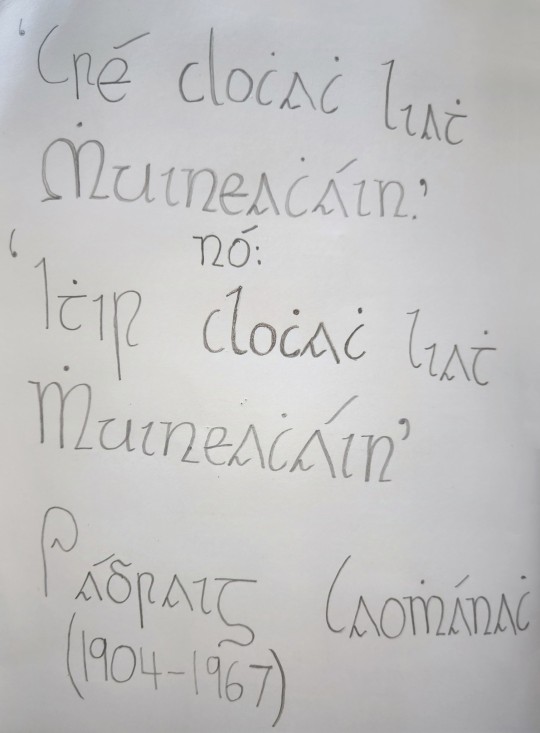
Figure 1: ‘the stony grey soil of Monaghan’ in Irish Gaelic, in my own handwriting.

Figure 2: ‘the stony grey soil of Monaghan’ in Irish Gaelic, in Bunchló Ársa.
____
* In Modern Standard Irish: ‘as Gaeilge’
2 notes
·
View notes
Text
The Motto of the Ulster Freedom Fighters: ‘Feriēns tegō’, ‘Striking, I defend’:
In this video, I examine the Latin motto of the Loyalist Terrorist group, the Ulster Freedom Fighters, which is: ‘Feriēns Tegō’, ‘striking, I defend’. This, of course, refers to the clenched fist, a clenched Red Hand of Ulster, depicted in the Ulster Freedom Fighters’ coat of arms. The Ulster Freedom Fighters is a nomme de guerre, a name of war, for the Ulster Defence Association, which was actually a legal organisation until it was eventually proscribed in 1992.
I discuss three extremely charismatic figures to have emerged from the Ulster Defence Association: Andy Tyrie, Ray Smallwoods (1949–1994) and John McMichael (1948–1987). I also briefly discuss the Independent Ulster movement, which seeks to make Northern Ireland an independent realm of the Commonwealth.
youtube
#history#latin#classics#northernireland#language#translation#ireland#irishhistory#education#linguistics#Youtube
0 notes
Text
‘in mediās rēs’ or: ‘[jumping] into the middle matters’: a style of storytelling:
In this video, I discuss a style of storytelling or a style of narration termed: ‘in mediās rēs’. Instead of beginning a novel at the beginning, and ending at the end, why not throw your protagonist into the middle matters of the novel. Then, as the novel progresses, alinear storytelling may be employed so as to fill in what happened in the beginning. Perhaps a novelist might do this by employing flashbacks. Perhaps the main character might be musing to himself/herself, in an angst-ridden state of mind as regards what happened in the beginning.
Latin Grammar (Parsing):
‘in’, Latin preposition that governs the accusative when motion towards something is implied. Hence, in this instance, we translate: ‘in’ as: ‘into’.
‘mediās’, Latin first and second declension adjective. A morphology of: ‘medius, media, medium’. ‘mediās’ is governed by the preposition: ‘in’, and agrees in gender, number and case with ‘rēs’. ‘mediās’ is feminine in gender; plural in number, and accusative in case. The Latin adjective: ‘medius’ means: ‘middle’.
‘rēs’, Latin 5th-declension feminine noun. A morphology of ‘rēs’ genitive singular: ‘rē̆i’. ‘rēs’ is governed by the preposition: ‘in’, and agrees in gender, number and case with ‘mediās’. ‘rēs’ is feminine in gender; plural in number, and accusative in case. The Latin noun: ‘rēs’ means: ‘thing’, or: ‘matter’.
Hence: ‘in mediās rēs’ is a Latin accusative phrase that means: ‘[jumping] into the middle things’ or: ‘jumping into the middle matters’.
youtube
#creative#creativeWriting#novels#Latin#translation#classics#writing#education#language#linguistics#Youtube
2 notes
·
View notes
Text
And Yet For All This God’s [Mysterious] Plan Was Being Accomplished:
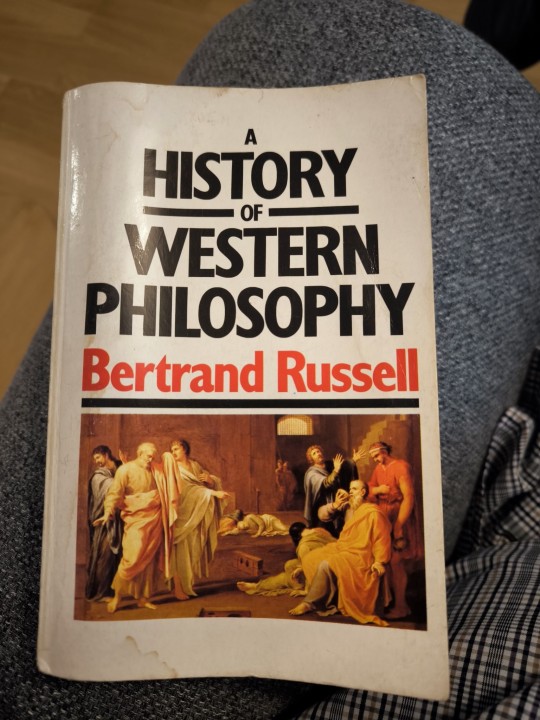
Figure 1: Pictured, Socrates’s drinking Hemlock, and dying, as recounted in the Phaedo.
The atheist philosopher, Bertrand Russell (1872–1970), in his ‘A History of Western Philosophy’ (1946–1961) seems to agree with Eric S. Mallin’s ‘The Godless Shakespeare’ (2007) in that Homer’s Iliad is really an atheistic satire of the gods.
I detect some atheistic satire in the opening line. A scene of madness, mayhem, murder and revenge greets us, and yet, for all this, God’s plan is being accomplished, or, in Greek:
«Διὸς δ᾽ ἐτελείετο βουλ��,»
or transliterated:
‘Diòs d’ eteleíeto boulḗ,’
. To me, in the original Greek, it appears as though the Homeric author is satirising the gods for allowing such ‘horrendous suffering’—as atheist philosopher John Loftus puts it—within their mysterious ‘plan’. Homer, like Shakespeare, seems to be criticising God for not intervening to prevent evil, in the opening line. In Macbeth, MacDuff complains against God’s providence in His not intervening to prevent MacDuff’s family from being murdered.
#greek#classics#philosophy#problemOfEvil#god#theism#translation#education#language#linguistics#atheism
2 notes
·
View notes
Text
Thinking Lorenzo Valla’s Thoughts After Him:
I am taking a look at the ‘Donation of Constantine’ in an attempt to think Lorenzo Valla’s (1407–1457) philological/Historical Linguistic thoughts after him. In my view, Lorenzo Valla kickstarted the Protestant Reformation. Erasmus (1466–1536) “laid the egg” of the Protestant Reformation and Martin Luther (1483–1546) “hatched it”. Both were readers of Valla. In those times, ‘catholic’—from the Greek phrase:
«καθ’ ὅλου»
or, transliterated:
‘kath’ hólou’
which means:
‘concerning the whole [world]’
i.e.:
‘universal’
—was essentially an adjective describing the nature of the Christian Church. Today, when we hear: ‘Catholic’ we think of a distinct sect of Christianity, i.e. the Roman Catholic one. And so, when “the Catholic Church” was caught in a lie, in the 1400s, before Protestantism really existed, then this was the same as catching the Christian Church, or indeed Christianity itself in a lie.
The Protestant Reformation thus kickstarted by Valla—and I agree with both Christopher Hitchens (1949–2011) and with the Freemasons that Protestantism is merely atheism in embryo—the Modern Secular World that we now enjoy, in developed countries, inexorably ensued.
In the Donation, pictured below, I am looking for divergences from Classical Latin.
As regards the first line of the Donation, classically, the:
‘In’
could be dropped, as:
‘nōmine’
is already in the ablative case. Post-classical Latin is more prepositional and less reliant on cases than Classical Latin. Also, Constantine would not have referred to himself as an:
The forger, below pictured, is using a post-classical word for ‘emperor’, whereas Constantine would have used: ‘prī̆nceps’, i.e.: ‘First [Citizen]’.
‘Imperātor’
#Latin, #Linguistics, #translation, #philology, #history, #greek,
—this meant ‘military commander’, in Classical Latin—but rather, he would have referred to himself as:
‘prī̆nceps’
.
____
0 notes